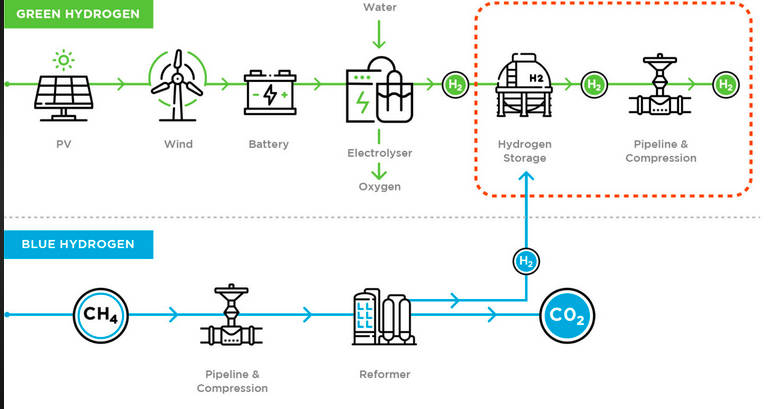The swing away from relying on fossil fuels is creating the need for substitute sources of energy. Solar and wind power are notable for providing cheap energy for electricity but energy for transport, especially trucks, shipping and planes, is harder to develop. One alternative is hydrogen which is simple and abundant, and is more readily storable than electricity. When it burns it generates energy in the form of heat, with water as a by-product rather than atmosphere-warming carbon dioxide.
Hydrogen can be made through electrolysis, where electricity is passed through a substance to force a chemical change — in this case, splitting H2O into hydrogen and oxygen. When the energy used to power electrolysis comes from renewable energy such as wind, water, or solar, it is considered Green Hydrogen.

Blue Hydrogen is made using natural gas by separating the hydrocarbons that make it up through the application of heat. This method requires a fossil fuel that generates carbon dioxide (CO2) and methane, both greenhouse gases (GHGs).
Generating hydrogen is also expensive, especially when compared to the very inexpensive solar and wind form of energy.
Some further ideas to explore on Green and Blue Hydrogen:
Compare the costs of green and blue hydrogen.
To what extent are green and blue hydrogen available in your area?
What are green and blue hydrogen used for in your area?
Sources:
Catherine Clifford, “Hydrogen power is gaining momentum, but critics say it’s neither efficient nor green enough,” CNBC (14 Jan 2022). cnb.cx/3u9ruJ6
Sophie Johnson, “Blue hydrogen v green hydrogen,” Ecologist (18 May 2021). bit.ly/3L4AVQr
Jim Magil, “Blue Vs. Green Hydrogen: Which Will The Market Choose?” Forbes (22 Feb 2021). bit.ly/3r91jR1


No comments yet, add your own below